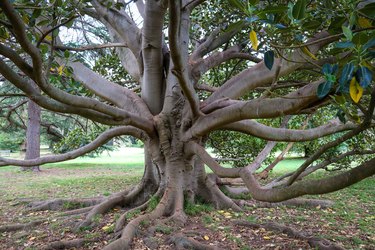
Weed and feed sounds like a dream product — it kills lawn weeds and fertilizes with one quick application. However, even though the product is intended to kill only grassy and broadleaf weeds, the herbicides used in the weed and feed potentially can harm other plants, including woody plants such as trees. The spacing necessary between trees and weed and feed products varies by tree. Careful and precise application of weed and feed is the only way to guarantee healthy and safe trees in your landscape.
Tip
When using weed and feed, a general guideline is to apply the product outside of the area of the tree canopy or where the branches overhang. The idea here is to avoid the root area, to prevent potential injury to the tree.
Video of the Day
Weed and Feed Basics
As far as best practices go, a grower or landscaper should never apply any type of chemical herbicide, including weed killer, within the root zone of a tree. The root zone is the area in which the roots spread, and it is also the place from which the tree absorbs its nutrients and water. Any chemicals in that area will be absorbed along with the water and nutrients, and the results of such exposure may adversely affect the health of a tree.
Video of the Day
Estimating the Root Zone
Trying to figure out the root zone area can be a little bit tricky. The size of a tree's root zone varies by the type of tree as well as its age. Younger trees have thinner, shorter roots, but as the tree grows, roots can extend outward from the tree from two to six times the radius of the canopy in all directions. This is especially true of thick, long-rooted trees such as maples (Acer spp.), willows (Salix spp.) and poplars (Populus spp.). Tree roots generally occupy the soil only 6 to 24 inches below the surface, so if you apply a chemical to the surface grass, it will inevitably sink down with water to the roots of the tree.
Consult a Tree Expert
When in doubt, don't apply weed and feed fertilizer anywhere under the branches of your tree. However, to be more accurate about your specific tree, consult a local county extension office, an arborist, professional landscaper or garden center for details regarding your species of tree. Such professionals will be able to estimate the size of the root zone based on the species and the age of the tree.
Weed and Feed Products to Avoid
Never use any weed and feed product that advertises that it kills broadleaf weeds. Even though most deciduous trees are considered "woody plants," including maple, birch (Betula spp.) and hickory (Carya spp.), they share a number of characteristics with broadleaf herbaceous plants and will easily be damaged by these chemicals. In general, most pre-emergent herbicides, which are designed to prevent weeds from sprouting, are safe to use near trees since the dose of chemical is not as strong. Using a natural weed control method, such as mulch, is another approach that you can consider.